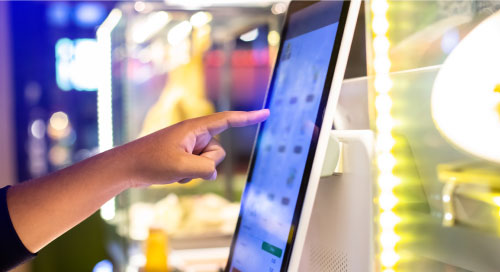Fill form to unlock content
Error - something went wrong!
Your content is just a step away. Please submit below.
Thank you!
Retail AI Solutions Speed Checkout—From Shops to Stadiums

In every type of commerce—from supermarkets to quick-serve restaurants and retail stores—consumers expect product choice, convenience, and timely service. But picture shopping in crowded venues like concerts, fairs, and sporting events, which can be frustrating for customers and challenging for concessionaires. When people go to grab a bite to eat or purchase souvenirs, they don’t want to miss a moment of action.
Retailers and shoppers alike find that self-service—be it at a sporting event or at a shopping mall—is a great option. For example, self-checkout kiosks and POS terminals powered by computer vision, AI-based scanners, and even voice recognition can eliminate long lines and expedite checkout. These technologies help retailers stay ahead of the competition—offering more convenience to customers while streamlining operations.
But it can be a challenge to deploy systems that communicate seamlessly with one another and with existing machines and merchandise. Retail systems integrators (SIs) that orchestrate self-checkout solutions face countless hours evaluating all the different hardware and software options to build a custom solution for each venue.
This is where experienced solutions aggregators come into play. They have tested and deployed many of the cutting-edge technologies available in today’s retail market, and have the know-how to integrate them into complete, end-to-end solutions. By collaborating with aggregators, SIs can save time, better serve their customers’ needs, and gain assurance that the advanced technologies they provide will function as intended.
Retail AI Solutions Delivered Right Out of the Box
For many retailers, automation and self-service technology can’t come soon enough. Stressed by employee shortages, demanding customers, and inflation-squeezed profit margins, they approach SIs to find ways of increasing efficiency, says David Lester, Business Development Manager at BlueStar, Inc., a global supplier of technology solutions for retailers, manufacturers, logistics companies, and other industries.
Specialized technologies have been developed to enhance efficiency and improve the customer experience across the retail spectrum. Working closely with SIs, BlueStar has assembled 30 unique “In-a-Box” solutions for retail operations ranging from quick-serve restaurants to malls, hotels, grocery stores, and boutiques. These ready-to-go bundled packages contain all the hardware, software, and accessories SIs need for deployment, minimizing decision-making and reducing setup time, Lester says.
“If you’re a systems integrator for a quick-serve restaurant, the last thing you want to do is source individual pieces for scanning, payment processing, inventory management, and everything else involved in a point-of-sale system. With a BlueStar In-a-Box solution, you open the box, set it on the counter, and start using it then and there,” Lester adds.
Helping Systems Integrators with AI Automation Technology
One increasingly popular retail technology—especially at drive-through QSRs—is voice-based AI, Lester says. For this use case, BlueStar partners with Sodaclick, a provider of interactive voice technology for digital ordering. “We like Sodaclick conversational voice AI because it is very good at understanding what customers want,” Lester says.
The Sodaclick conversational virtual assistant, used at drive-throughs and kiosks, uses Intel® RealSense™ 3D cameras to recognize approaching customers, and can be programmed to understand English, Spanish, Mandarin Chinese, and more than 100 other languages and regional accents. The system responds to customers in natural-sounding language and can offer suggestions and promotions based on demographics, time of day, or other metrics that retailers choose.
The combination of voice recognition and #ComputerVision also works well at stores with self-service #payment systems, where merchandise recognition can be tricky. @Think_BlueStar via @insightdottech
The combination of voice recognition and computer vision also works well at stores with self-service payment systems, where merchandise recognition can be tricky.
That was the case at the Fayetteville, Georgia-based fully automated grocery store Nourish + Bloom Market. When the store’s item-recognition software failed to properly account for salads and other deli items, the company asked SI UST Global Inc for help. UST worked with BlueStar to upgrade the store’s checkout experience with Sodaclick Conversational Voice AI, the UST Vision Checkout system, and automated payment processors, as well as kiosks, scales, cables, and other associated hardware.
Customers can now purchase any items in the store without human assistance. UST Vision Checkout includes ceiling-mounted cameras, to recognize and record the prices of packaged items as soon they are removed from shelves and placed in a shopping cart. For salads and other deli products that must be weighed, the customer describes the item to the Sodaclick voice assistant before placing them on a scale. Coordination between the voice system and computer vision cameras results in accurate pricing. After all items are checked, the customer simply tells the voice assistant “pay now” and completes the transaction with a cell phone. “It’s a frictionless process and a great convenience for customers,” Lester says.
Building Tomorrow’s Retail Infrastructure
As edge AI capabilities improve, BlueStar is expanding the range of its solutions. For example, it is currently developing integrations with clothing technology company FIT:MATCH, which uses Lidar and AI to capture 3D images of a customer’s body shape and match them to a digital twin in the database. The system can then make individualized recommendations for products and sizing.
Working with Intel helps BlueStar keep up with innovative applications such as this. “Intel plays a pivotal role with us, especially for our In-a-Box solutions,” Lester says. “They’ve helped us tremendously in learning about AI solutions and deploying them as cost-effectively as possible.”
As futuristic as some of the new AI applications may sound, Lester believes they will continue to improve: “I’m seeing advancements in artificial intelligence every month. I think voice AI and digital signage will evolve to become more intuitive, improving contextual understanding and providing even more personalized experiences and better customer engagement.”
Discover more about voice enabled solutions. Listen to our podcast: QSRs—Voice AI Will Now Take Your Order: With Sodaclick.
This article was edited by Georganne Benesch, Editorial Director for insight.tech.
This article was originally published on April 8, 2024.